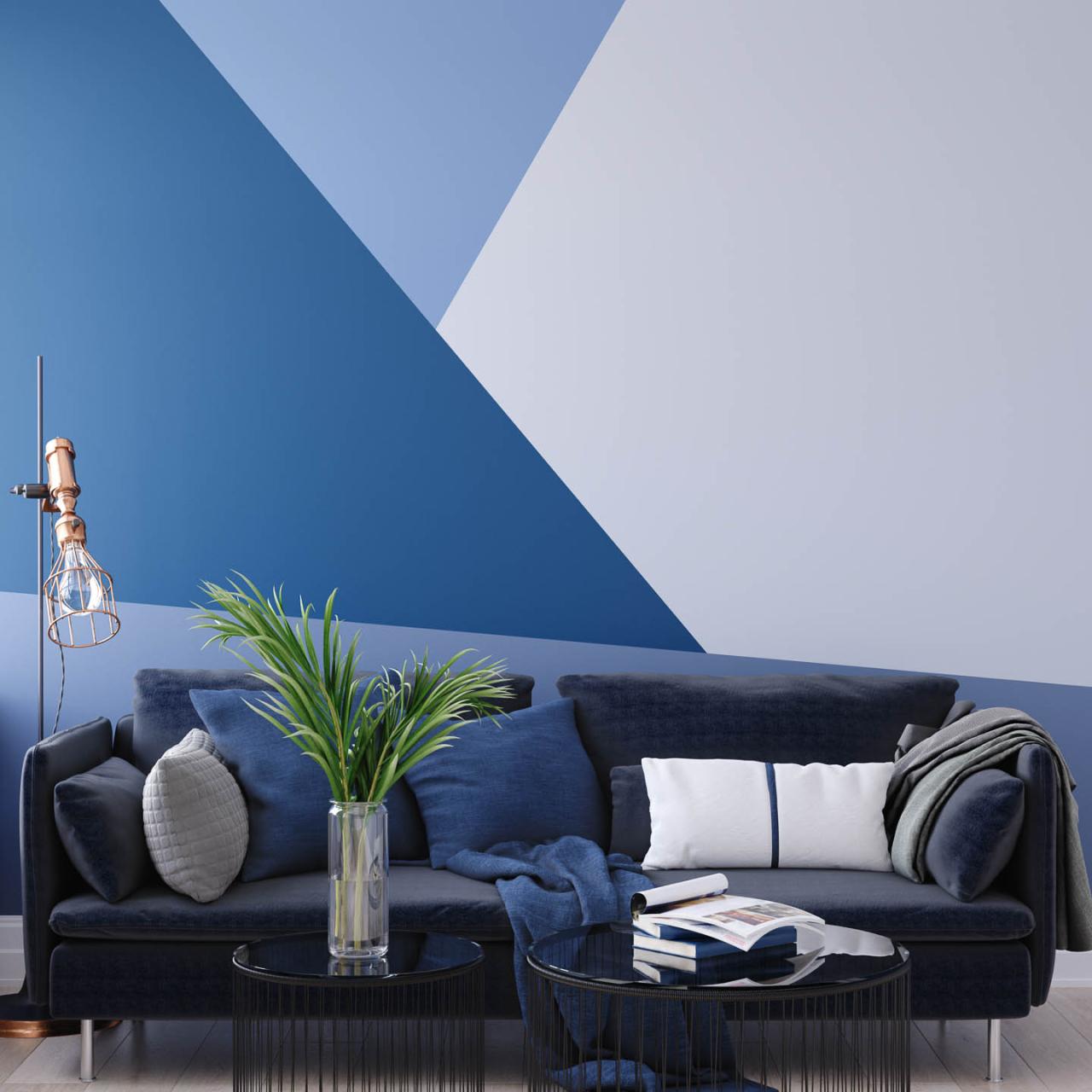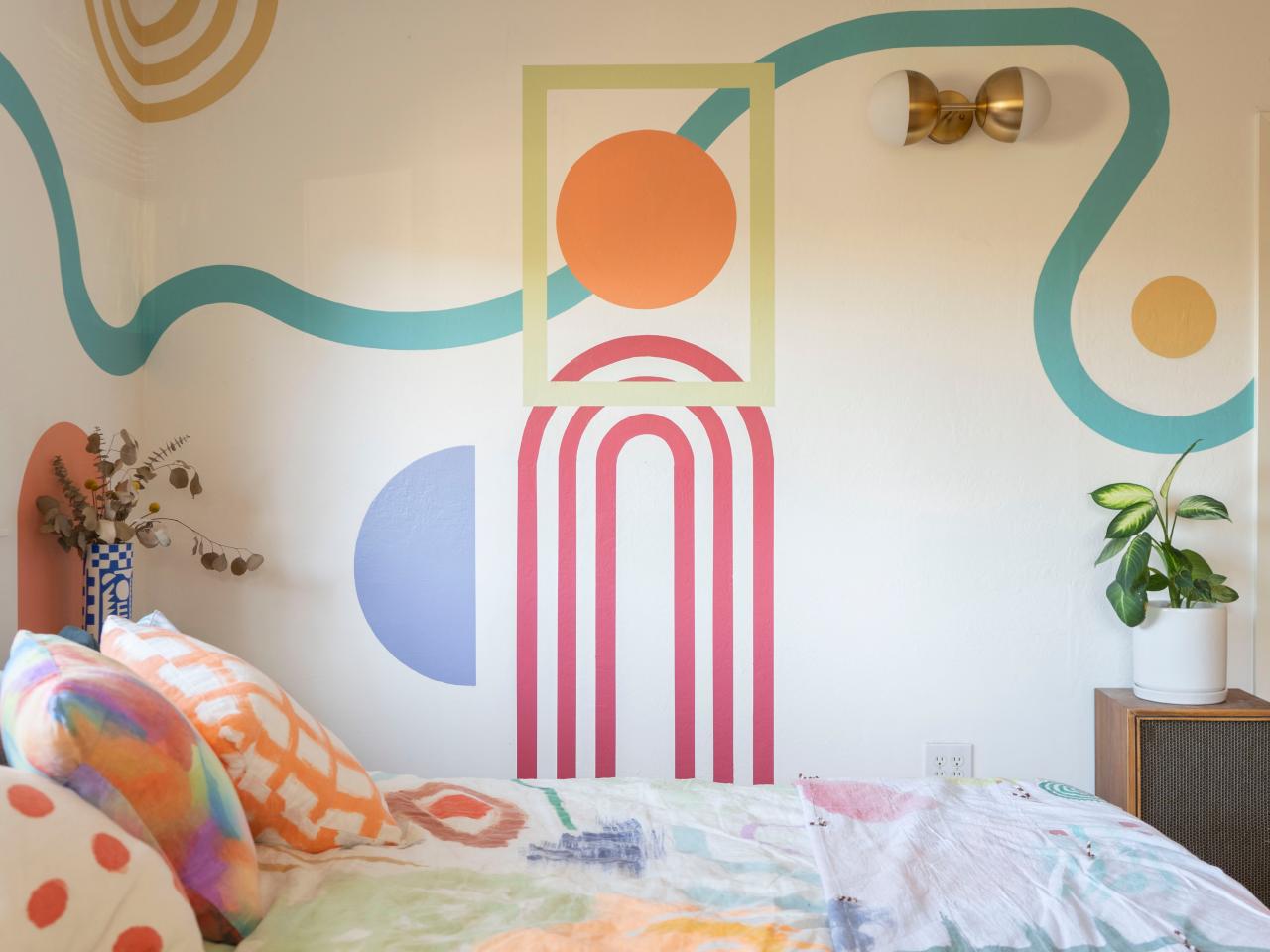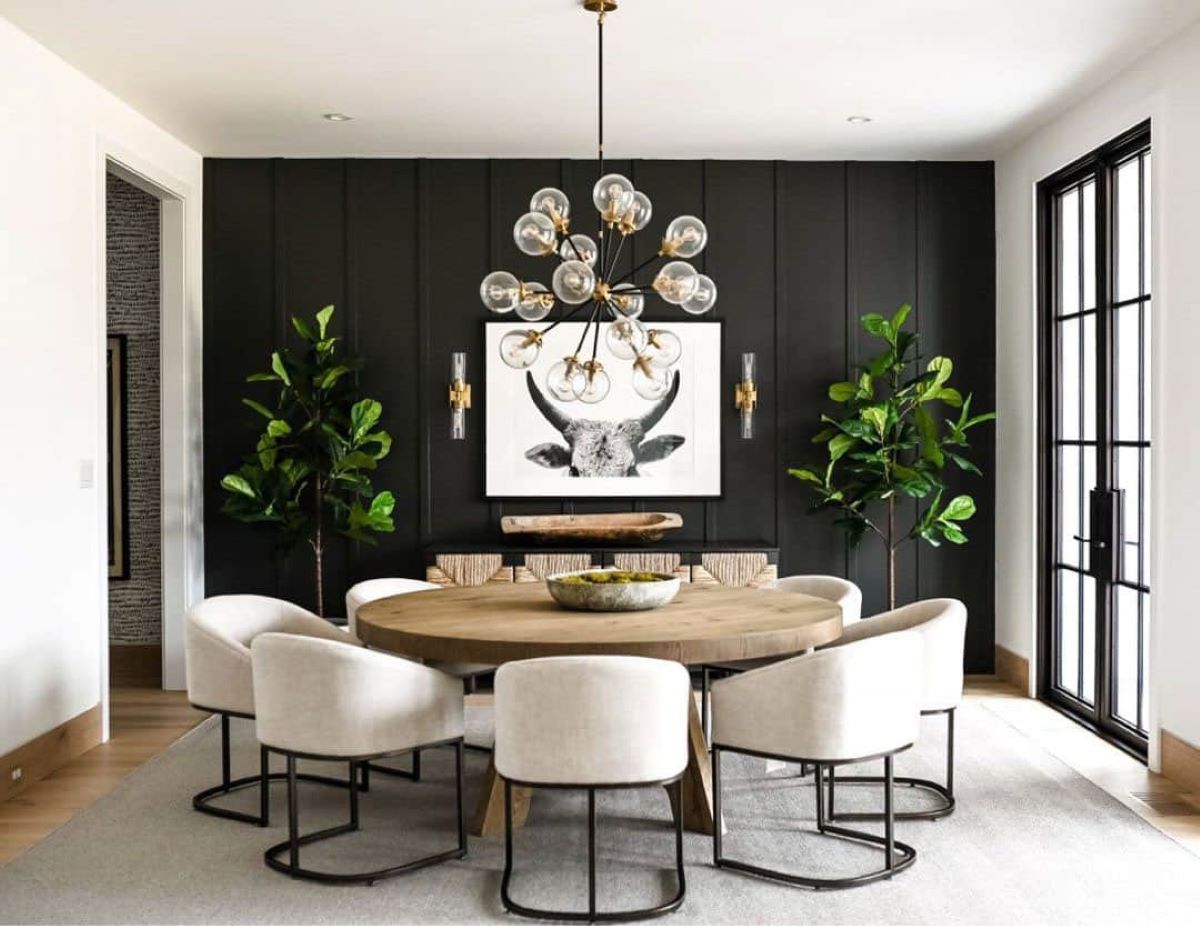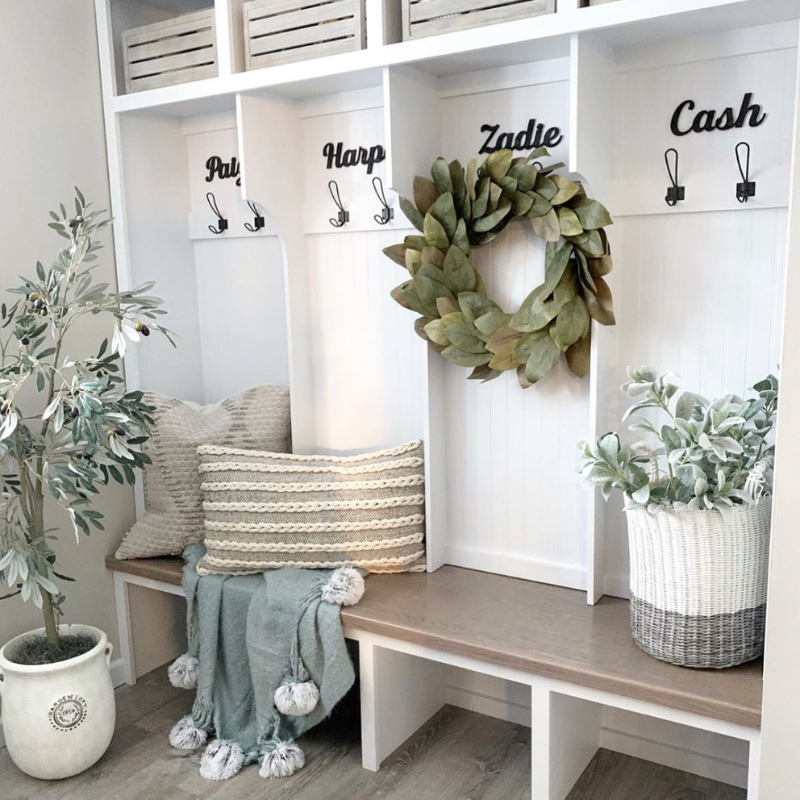Simple wall painting ideas can breathe new life into any room, adding personality and visual interest without overwhelming the space. Whether you’re a seasoned DIY enthusiast or a novice painter, these easy-to-implement techniques offer a creative outlet to express your style and transform your home.
From geometric patterns and stripes to color blocking and nature-inspired designs, there’s a wide array of options to explore. Whether you prefer a minimalist aesthetic or a bold statement, these ideas cater to various tastes and skill levels, making it easy to find a project that suits your preferences and enhances your home’s overall ambiance.
Geometric Patterns

Geometric patterns are a timeless and versatile design element that can add visual interest and a touch of sophistication to any room. From simple lines and shapes to intricate mosaics, geometric patterns can be used to create a wide range of styles, from modern and minimalist to traditional and eclectic.
Creating Geometric Wall Patterns
Geometric patterns can be easily created using painter’s tape, which allows you to create clean, precise lines and shapes. Here is a step-by-step guide on how to create a geometric wall pattern using painter’s tape:
1. Prepare the wall: Clean the wall surface and ensure it is free of dust, dirt, or debris.
2. Choose your pattern: Select a geometric pattern that you like. You can find inspiration online or in design magazines.
3. Measure and mark: Use a measuring tape and pencil to mark out the pattern on the wall.
4. Apply painter’s tape: Carefully apply painter’s tape along the marked lines. Ensure that the tape is pressed firmly against the wall to prevent paint from bleeding underneath.
5. Paint: Apply paint to the sections of the wall that you want to be colored. Use a roller or brush for a smooth finish.
6. Remove the tape: Once the paint is dry, carefully remove the painter’s tape.
7. Enjoy your new wall: You can add a few finishing touches, such as adding stencils or applying a clear sealant, to protect the painted surface.
Examples of Geometric Wall Patterns
Here are some examples of geometric patterns that can be used for accent walls or entire rooms:
- Stripes: Vertical or horizontal stripes are a classic and easy-to-create geometric pattern. You can use different colors and widths to create a variety of looks.
- Chevrons: Chevron patterns are created by alternating V-shaped lines. They can be used to add a sense of movement and energy to a room.
- Triangles: Triangles can be arranged in a variety of ways to create interesting patterns. You can use different colors and sizes to create a unique design.
- Circles: Circles can be used to create a sense of flow and movement. You can arrange them in a grid pattern or use them to create a more organic design.
- Squares: Squares can be used to create a sense of order and structure. You can use different colors and sizes to create a unique design.
Tips for Creating Geometric Wall Patterns
- Use high-quality painter’s tape: This will help to ensure that your lines are clean and crisp.
- Plan your pattern carefully: Before you start painting, sketch out your pattern on paper to ensure that it will fit the space.
- Use a level: This will help to ensure that your lines are straight.
- Don’t be afraid to experiment: Geometric patterns can be customized to suit your personal style. Don’t be afraid to try different colors, shapes, and sizes.
Stripes and Lines
Stripes and lines are a classic and versatile design element that can instantly transform a plain wall into a stylish and eye-catching feature. They offer a simple yet effective way to add visual interest, create a sense of movement, and define different areas within a room.
Creating Stripes and Lines
There are several methods for creating stripes and lines on a wall, each with its own advantages and considerations:
- Painter’s Tape: This is a popular and precise method for achieving clean, crisp lines. Simply apply painter’s tape to the wall in the desired pattern, ensuring the tape is firmly pressed down to prevent paint bleed. Then, paint the stripes with your chosen color, carefully removing the tape once the paint is dry.
- Stencils: Stencils offer a more intricate and detailed approach to creating stripes and lines. They come in various patterns and sizes, allowing you to create unique and personalized designs. To use a stencil, simply place it on the wall, secure it with tape, and apply paint through the cutouts.
- Freehand Painting: For a more free-flowing and artistic look, you can try freehand painting stripes and lines. This method requires a steady hand and some practice, but it allows for greater creativity and flexibility. You can use a brush, roller, or even a sponge to create different textures and effects.
Stripe Patterns
Stripes can be arranged in various patterns to create different visual effects and moods:
- Horizontal Stripes: Horizontal stripes create a sense of width and can make a room feel larger. They are also a great way to emphasize the length of a wall.
- Vertical Stripes: Vertical stripes create a sense of height and can make a room feel taller. They can also draw the eye upwards, creating a more dramatic effect.
- Diagonal Stripes: Diagonal stripes add a dynamic and energetic feel to a room. They can create a sense of movement and can be used to accentuate a particular area.
- Chevron Stripes: Chevron stripes are a more intricate pattern that adds a sophisticated and modern touch. They are created by alternating two sets of diagonal stripes that meet at a point.
Using Stripes to Define Spaces
Stripes can be used to visually define different areas within a room, creating a sense of separation and organization. For example, you can use stripes to:
- Create a focal point: A bold stripe pattern behind a sofa or bed can draw the eye to that area and make it feel more prominent.
- Divide a room: Stripes can be used to visually divide a large room into smaller, more intimate spaces. For instance, you could use vertical stripes to separate a dining area from a living area.
- Highlight a feature: Stripes can be used to highlight a specific architectural feature, such as a fireplace or a window.
Color Blocking: Simple Wall Painting Ideas
Color blocking is a design technique that involves using large blocks of solid color to create visual interest and define different areas within a space. It’s a great way to add a bold statement to your walls and create a modern and dynamic look.
Color Combinations
Color combinations play a crucial role in successful color blocking. Choosing complementary or contrasting colors can dramatically impact the overall feel of the room.
Here are some examples of color combinations that work well together:
- Complementary Colors: These colors sit opposite each other on the color wheel, creating a high-contrast effect. Examples include blue and orange, red and green, yellow and purple.
- Analogous Colors: These colors sit next to each other on the color wheel, creating a harmonious and cohesive look. Examples include blue, blue-green, and green, or yellow, yellow-orange, and orange.
- Monochromatic Colors: These colors are different shades of the same hue, creating a sophisticated and calming effect. Examples include various shades of blue, green, or gray.
Color Blocking for Different Room Types
Color blocking can be used in various rooms to create unique and personalized spaces. Here are some color combination ideas for different room types:
| Room Type | Color Combinations |
|---|---|
| Bedroom |
|
| Living Room |
|
| Kitchen |
|
Accent Walls
Accent walls are a popular design technique that involves highlighting one wall in a room with a different color, texture, or pattern than the other walls. This simple yet effective approach can dramatically transform the look and feel of a space, adding visual interest, defining areas, and creating a focal point.
Using Bold Colors
Accent walls allow you to introduce a splash of color without overwhelming the entire room. Choosing a bold color for your accent wall can create a statement and define a specific area. For instance, a vibrant blue accent wall in a living room can add a sense of energy and sophistication, while a warm terracotta accent wall in a bedroom can create a cozy and inviting atmosphere. When selecting a bold color, consider the overall color scheme of the room and the desired mood you want to achieve.
Adding Unique Textures
Adding texture to an accent wall provides a tactile element that can enhance the room’s visual appeal. Using textured wallpaper, exposed brick, or wood paneling can create depth and dimension, making the wall stand out. For example, a textured wallpaper with a subtle pattern can add a touch of elegance to a dining room, while exposed brick can create a rustic and industrial feel in a living room.
Incorporating Patterned Wallpaper
Patterned wallpaper is a versatile and eye-catching option for accent walls. It can add personality and visual interest to a space, creating a focal point and defining a specific area. For example, a floral patterned wallpaper can create a romantic and feminine atmosphere in a bedroom, while a geometric patterned wallpaper can add a modern and edgy touch to a living room.
Choosing an Accent Wall
When deciding on an accent wall, consider the room’s layout and existing decor.
- In a living room, consider placing the accent wall behind the sofa or fireplace to create a focal point and define the seating area.
- In a bedroom, an accent wall behind the headboard can add visual interest and create a cozy atmosphere.
- In a dining room, an accent wall behind the dining table can create a statement and define the dining area.
The color, texture, or pattern you choose for your accent wall should complement the existing decor and create a cohesive look.
Nature-Inspired Designs
Bring the tranquility of nature indoors with wall paintings inspired by its beauty. Whether you prefer the delicate details of a blooming flower or the bold silhouette of a majestic tree, nature offers endless inspiration for creating stunning and unique wall art.
Examples of Nature-Inspired Wall Art, Simple wall painting ideas
Nature-inspired wall art can take many forms, ranging from realistic depictions to abstract interpretations.
- Floral Motifs: A classic choice, floral designs can add a touch of elegance and vibrancy to any space. Consider painting delicate blossoms, intricate leaves, or bold floral arrangements in various colors and patterns.
- Tree Silhouettes: The graceful branches and majestic forms of trees offer a striking visual impact. Paint a single tree silhouette in a contrasting color against a neutral background, or create a forest scene with multiple trees in different sizes and shades.
- Animal Silhouettes: For a touch of whimsy and personality, incorporate animal silhouettes into your wall art. Choose from a variety of creatures, such as birds, butterflies, deer, or even playful animals like rabbits or squirrels.
- Abstract Landscapes: Capture the essence of nature through abstract interpretations. Use brushstrokes and color variations to depict rolling hills, flowing rivers, or the vastness of the sky.
Creating Nature-Inspired Wall Art
There are two primary methods for creating nature-inspired wall art: stencils and freehand painting.
- Stencils: Stencils provide a convenient and precise way to create intricate designs. You can find a wide variety of stencils online or at craft stores, featuring various floral, animal, and geometric patterns inspired by nature. Apply paint through the stencil to create a clean and defined design on your wall.
- Freehand Painting: For those with a more artistic flair, freehand painting allows for greater creativity and customization. Use brushes or sponges to create different textures and effects, mimicking the organic forms of nature. Start with simple shapes and gradually build up your design, adding details and color variations as you go.
Choosing Colors and Patterns
The colors and patterns you choose for your nature-inspired wall art play a crucial role in setting the mood and aesthetic of the space.
- Color Palette: Consider the natural colors of the elements you’re depicting. For example, use earthy tones like browns, greens, and yellows for trees and landscapes, while vibrant hues like reds, oranges, and purples can be used for flowers and birds.
- Patterns: Natural patterns can be incorporated into your designs. Use repeating motifs like leaves, flowers, or animal prints to create a sense of rhythm and harmony. You can also incorporate organic textures by using different brushstrokes or applying paint with a sponge.
Textured Walls
Adding texture to your walls can instantly transform a room, creating depth, visual interest, and a unique character. Textured walls can be achieved using various techniques and materials, allowing you to express your personal style and create a captivating ambiance.
Texturing Techniques
Different techniques can be used to create textured walls, each offering a distinct look and feel.
- Sponging: This technique involves using a natural or synthetic sponge to apply paint in a dabbing motion, creating a subtle, uneven texture. You can achieve various effects by changing the sponge’s size, shape, and pressure.
- Brushing: Using a brush, you can create textured patterns by applying paint in a circular, criss-cross, or random motion. This technique is versatile and allows for a range of effects, from subtle to dramatic.
- Stencilling: Stencils offer a way to create precise and intricate patterns on walls. By applying paint through a stencil, you can achieve geometric shapes, floral motifs, or abstract designs.
Textured Wall Designs
Textured walls can be achieved using various materials, each offering unique aesthetic and functional properties.
- Plaster: Plaster offers a versatile material for creating textured walls. You can apply plaster using various techniques, including troweling, stamping, or using a textured roller. Plaster can be used to create a range of textures, from smooth and subtle to rough and dramatic.
- Paint: Textured paints, also known as “embossed” or “heavy-bodied” paints, contain additives that create a raised texture. These paints can be applied using a brush, roller, or trowel, creating a variety of effects, from subtle stippling to bold patterns.
- Wallpaper: Textured wallpaper offers a quick and easy way to add texture to walls. There are numerous options available, from subtle embossed patterns to bold three-dimensional designs. Textured wallpaper is also a great way to add insulation and sound absorption to a room.
Pros and Cons of Texturing Methods
Each texturing method has its advantages and disadvantages, depending on the desired effect, budget, and skill level.
| Method | Pros | Cons |
|---|---|---|
| Sponging | Easy to apply, creates a subtle texture, affordable | Limited in design options, can be messy |
| Brushing | Versatile, allows for a range of effects, affordable | Can be time-consuming, requires some skill |
| Stencilling | Creates precise and intricate patterns, offers a wide range of designs | Requires more time and effort, can be challenging for beginners |
| Plaster | Durable, creates a wide range of textures, can be customized | Can be messy and time-consuming, requires some skill |
| Textured Paint | Easy to apply, offers a variety of textures, affordable | Limited in design options, may not be as durable as plaster |
| Textured Wallpaper | Quick and easy to install, offers a wide range of designs, can add insulation and sound absorption | Can be expensive, may not be as durable as other methods |
Wall Murals
Wall murals can transform a plain wall into a stunning focal point, adding personality and visual interest to any space. Whether you’re looking to create a whimsical scene in your child’s room, a serene landscape in your bedroom, or a bold geometric design in your living room, wall murals offer a unique opportunity to express your creativity and personalize your home.
Creating a Wall Mural
There are several ways to create a wall mural, each with its own advantages and considerations:
- Stencils: Stencils provide a simple and efficient way to create repeating patterns, intricate designs, or even words on your wall. They are available in various sizes and designs, from basic geometric shapes to complex floral motifs. Stencils are particularly useful for beginners, as they offer a degree of precision and control over the design.
- Freehand Painting: Freehand painting allows for maximum creative freedom and the ability to create truly unique and personalized designs. This method requires some artistic skill and practice, but it offers the most flexibility in terms of design and color choices. If you’re comfortable with a brush and have a clear vision for your mural, freehand painting can be a rewarding and fulfilling experience.
- Projector: Using a projector to transfer a design onto your wall is a convenient and accurate method for creating large-scale murals. You can find pre-designed images online or create your own using graphic design software. Projecting the image onto the wall allows you to trace the Artikel and then paint within the lines. This method is particularly helpful for complex designs or intricate details.
Simple Wall Mural Ideas for Beginners
Here are a few simple wall mural ideas that are perfect for beginners:
- Geometric Patterns: Simple geometric patterns like stripes, polka dots, or triangles can create a visually appealing and modern look. You can use stencils or freehand painting to create these patterns, and they can be adapted to fit any room style.
- Favorite Quote: A favorite quote or inspirational phrase can be a meaningful and personal addition to your wall. You can use stencils or freehand painting to create the text, and you can customize the font and color to match your decor.
- Nature-Inspired Designs: Simple nature-inspired designs like leaves, branches, or flowers can add a touch of tranquility and beauty to your space. You can use stencils or freehand painting to create these designs, and they can be customized with different colors and textures.
Statement Walls
A statement wall is a focal point in a room, designed to draw attention and create a sense of visual interest. It can be achieved using bold colors, unique patterns, or interesting textures, adding personality and character to your space.
Examples of Statement Wall Ideas
Here are some statement wall ideas for different rooms in the house:
- Living Room: A dark, rich hue like navy blue or emerald green can create a sophisticated and cozy atmosphere. You can also use a geometric pattern wallpaper or a textured wall treatment like brick or wood panels for a more dramatic effect.
- Bedroom: A calming color like pale blue or lavender can promote relaxation. A floral mural or a wallpaper with a subtle pattern can add a touch of elegance and femininity.
- Dining Room: A bold accent wall in a vibrant color like red or orange can create a lively and inviting ambiance. A textured wallpaper or a metallic paint can add a touch of glamor and sophistication.
- Home Office: A bright and cheerful color like yellow or green can boost productivity and creativity. A chalkboard paint or a magnetic wall can provide a functional and stylish backdrop for your workspace.
Choosing the Right Statement Wall
The choice of statement wall should be based on the room’s purpose and style.
- Consider the room’s function: In a living room, you might choose a bold color or a dramatic pattern to create a focal point. In a bedroom, you might opt for a calming color or a subtle pattern to promote relaxation.
- Think about the existing decor: If your furniture and accessories are neutral, you can use a statement wall to add a pop of color or pattern. If your decor is already bold, you might want to choose a more subtle statement wall to avoid overwhelming the space.
- Experiment with different options: Don’t be afraid to experiment with different colors, patterns, and textures to find the perfect statement wall for your space. You can use paint samples or wallpaper swatches to visualize how different options would look in your room.
Minimalist Designs
Minimalist wall painting designs embrace simplicity, using clean lines, geometric shapes, and a limited color palette to create a sense of calm and sophistication. These designs prioritize a clean and uncluttered look, allowing the space to breathe and the artwork to stand out.
Examples of Minimalist Wall Art
Minimalist wall art often features simple geometric shapes, such as circles, squares, and triangles, in a single color or a limited color scheme. A classic example is a single, large circle painted in a bold color against a neutral background. Another popular option is a series of vertical or horizontal lines in different widths and colors, creating a visually appealing and minimalist pattern.
Choosing Colors and Patterns
When selecting colors and patterns for a minimalist wall painting, it’s essential to choose options that complement the overall aesthetic.
* Color Palette: Neutral colors like white, gray, beige, and black are excellent choices for a minimalist background. These colors provide a clean canvas for the artwork to stand out. You can introduce pops of color with accents like a single bold line or a geometric shape in a contrasting hue.
* Patterns: Keep patterns simple and geometric. Stripes, dots, or a series of repeating shapes can add visual interest without overwhelming the space. Avoid intricate or busy patterns that can detract from the minimalist aesthetic.
* Texture: Consider incorporating subtle texture into the paint to add depth and dimension to the wall. For instance, a textured paint finish can create a subtle pattern or a sense of movement, adding visual interest without being overly busy.
Final Review
With a little creativity and the right tools, you can achieve stunning results with simple wall painting ideas. These techniques offer a budget-friendly and impactful way to personalize your space, making it a reflection of your unique style and personality. Whether you’re seeking to create a calming oasis or a vibrant focal point, these ideas provide the perfect starting point for a rewarding DIY project.
Simple wall painting ideas can be a great way to add personality to your space. If you’re looking for inspiration, you might want to check out some art craft ideas that can help you develop your own unique design.
For example, geometric shapes, abstract patterns, or even simple stripes can create a striking visual impact.




